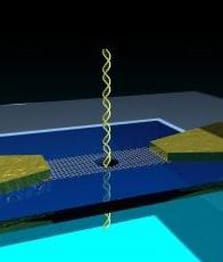Graphene Provides Breakthrough to Nanopore Sequencing Technology

Graphene based Nanopores may be the technological leap that researchers have been looking for achieving reduced error rates in solid state nanopore sequencing. Researchers at École polytechnique fédérale de Lausanne in Switzerland are reporting success in using graphene nanoribbons in solid state nanopore tip to reduce error rates and achieve faster sequencing.
Nanopore technology has been around for more than a decade and it promises sub $100 human DNA sequencing abilities. However, companies such as Oxford Nanopore and individual researchers have been unable to reduce the error rates in existing technologies. This is mainly because the exiting materials used to create nanopores are 15nm thick, while the space between two DNA based is 0.335 nm. This leads to reading more than one base at a time and ultimately increased error rates.
However, graphene nanoribbon transistors with a thickness of 0.335 nm provide researchers with the ideal sized nanopore materials to read single bases. By diluting DNA molecules in ion solution and driving them through graphene transistor pores, researchers were able to detect individual molecules based on the changes in the electric field and disturbance caused to the current passed through the graphene. Graphene gave researchers the ability to reduce the thickness of the nanopore to a single molecule and maintain the orifice strength at the same time.
Using graphenes in nanopores still has a long way to go when it comes to live real time sequencing. Although in initial experiments, researchers were able to pass 50,000 DNA bases in 5 milliseconds through the pores, the ouput signal received was not clear enough to differentiate individual bases. However, the lead researcher of the study published in Nature Nanotechnology, Aleksandra Radenovic believes that this success provides a “significant breakthrough as well as a significant opportunity” for sequencing.

